Your progress
0%

Use your mouse or keyboard to expand each of the activity headings below. To add an activity to your action plan, select the Add button beside it. Once you have added an activity to your action plan, select Action plan > My action plan from the menu above to complete that activity.
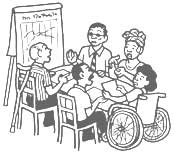
There are many activities that CBR can carry out to ensure that people with disabilities, their families and communities are prepared for a potential crisis, such as a natural disaster. These include the following:
Learn about how one man with disabilities helped to provide training for others about how to prepare for emergencies.
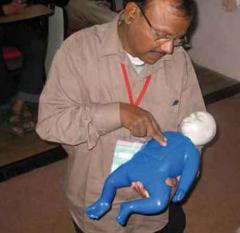

The Emmanuel Hospital Association (EHA) has been working in India since 1970 with a mission to “transform communities through caring”. Many of EHA’s hospitals and programmes are implemented in disaster-prone areas. In 2006, the Disaster Management & Mitigation Unit was established in response to the need for a more systematic disaster preparedness and capacity building programme. With the support of CBM and building on a previous disaster preparedness project funded by ECHO, they developed a pilot project, “Disaster Preparedness through Training & Capacity Building in the Northeast region of India”, to explore inclusion of disability in disaster preparedness programmes. The project was successfully implemented in eight states.
The project targeted several groups of people, including:
EHA trained more than 3,000 community volunteers and professionals in First Aid, Basic Disaster response, Basic Life Support and Advanced Cardiac Life support, and linked each of the local instructors to their own capacity development unit. Building the capacity of individuals and professionals within communities prone to disaster risks is extremely important, as they can become key agents for change through raising awareness and spreading early warning messages as well as being the first to respond to disasters. With this increased knowledge, they are better equipped to address authorities and urge them to take their responsibility for Disaster Risk Management to allocate sufficient resources at the community level.
Mr. Paulus Masih was a member of the Disaster Preparedness project’s Core Support Team and was actively engaged in Emmanuel Hospital Association’s training and disaster management planning in the hospital. He received instructors’ training for First Aid during this time. When he was just around 18 years old, he had an unfortunate accident that severely injured his left foot and part of his right hand. He recalls, “With the knowledge about medical first aid, I could have saved my foot from such discomfort and partial disability”.
He recounts the following about his experience: “I am particularly glad that I had the privilege to be in the Core Team. This programme was very different since EHA included disabled people in training and planning, even in the Gaon (village committee) panchayat level. This was an excellent work done by the team.”
The large team of volunteers that Mr. Masih worked with included community members, as well local taxi drivers and police. They were trained in First Aid to help prevent injuries from becoming permanent impairments, and were trained together with people with disabilities. They helped to build many structural changes, including a ramp with railings to a pharmacy counter, holders in toilet and levelling all important areas so that wheelchairs could move around without difficulty. They also protected costly equipment by anchoring them throughout the hospital in to prevent them from becoming falling hazards during earthquake.
Footnote:
This story was retrieved and edited from the Disability Inclusive Disaster Risk Management publication from CBM and the Disability Inclusive Network DRR.
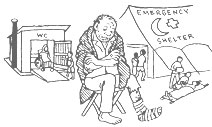
During a humanitarian crisis, emergency risk management systems and organizations may not always be inclusive of people with disabilities due to limited resources, attitudinal barriers, and lack of understanding of the needs of people with disabilities. There are many things that CBR can do to help ensure that an emergency response is inclusive of the needs of people with disabilities and their families. These actions centre on four main goals:
Learn about how a young man with disabilities takes part to prepare for emergency response in his community.
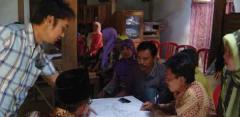

Waluyo is 24 years old and usually helps his family working the fields. He is one of the members of the Ngangkruk Hamlet Disaster Preparedness Team that was formed through the inclusive disaster risk management project implemented by Yakkum Rehabilitation Centre. Waluyo has a hearing impairment and is representing people with disabilities in the preparedness team in case of a disaster.
Ngangkruk hamlet is part of Gunungkidul District in Yogyakarta Province. This area is located in hilly terrain, which makes them susceptible to landslides during extreme storms and rain. Through training on inclusive disaster risk management, people in the village are now aware of how to react in case of a disaster. They have defined evacuation routes and, for example, the neighbours of households where people with disabilities live have been trained to communicate with and support people for evacuation.
Waluyo says he benefitted a lot from participating in the DRR program, “I am so happy because I feel appreciated,” he said. He has gained an important role in the village after taking part in creating a village evacuation route map, including the location of the houses of people with disabilities and other vulnerable people such as elderly, and disseminating the programme to the hamlet’s members. In the Hamlet Disaster Preparedness Team, Waluyo is now in charge of food logistics. His duties would be preparing food supplies with five others, if there were refugees in a disaster situation.
Today Waluyo and other people with disabilities living in Ngangkruk feel less worried about possible emergencies in the village. They are now equipped with skills and knowledge that help them to know what to do when emergency situations happen.
Footnote:
Dr. Maria Widago
Director
Yakkum Rehabilitation Centre, Yogyakarta, Indonesia
www.yakkum-rehabilitation.org
This story was retrieved and edited from the Disability Inclusive Disaster Risk Management publication from CBM and the Disability Inclusive Network DRR.
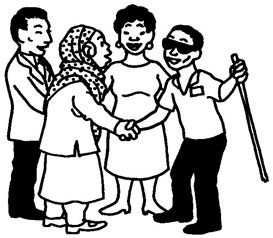
When a humanitarian crisis begins to stabilize, infrastructure gradually begins to be built and services start to be delivered again through the normal processes or channels. A crisis can provide new opportunities for development and CBR should take advantage of these opportunities to ensure that communities are rebuilt to be more inclusive. CBR can take the following actions:
Learn about how a community in Indonesia rebuilt work opportunities with the help of CBR after an earthquake.
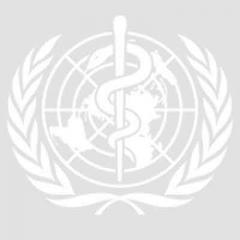

After a disastrous earthquake in Indonesia, many people became disabled or developed post-traumatic stress disorders and lost their sources of income. They decided to work together to change their situation. With assistance from CBR, they established a cooperative society. A non-governmental organization provided capital as well as technical assistance to the group. The cooperative provides loans and business advice for its members, who are involved in enterprises, such as brick-making, batik cloth-making and food selling. The cooperative has gradually expanded work opportunities in the community and increased members’ income.